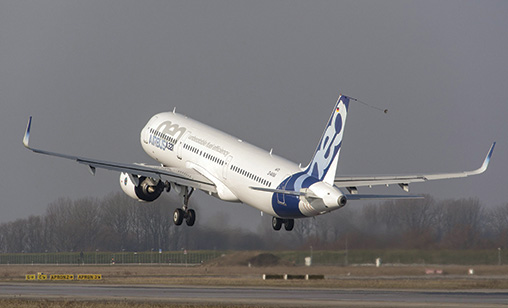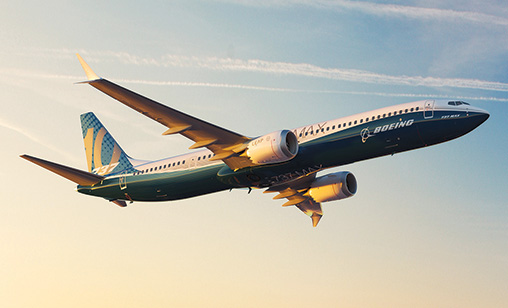Asia-Pacific Airline Market Forecast
Asia-Pacific remains dominant future airline market say manufacturers
July 1st 2017
The Asia-Pacific will continue to lead the world in total aircraft orders and deliveries in the next two decades as demand for single aisle aircraft remained strong, but the appetite for very large aircraft is diminishing quickly, the major manufacturers have predicted. Read More »
In Airbus’ latest global market forecast, unveiled on June 9, the Toulouse manufacturer raised its 20-year forecast from 33,070 aircraft, predicted a year ago, to 34,900 jets, worth US$5.3 trillion. But it trimmed its traffic growth outlook from 4.5% a year to 4.4%, which reflected caution about the subduing of the mature markets of North America and Europe.
 |
 |
“The growth is in the Asia-Pacific,” Airbus Commercial Aircraft chief operating officer - customers, John Leahy, told Orient Aviation in Toulouse. “Of course, Europe and North America are growing too, but nowhere near as fast. It’s the Asia-Pacific that’s driving the growth around the world. In 20 years, the number one domestic market by far is going to be domestic China,” he said.
Of the 34,900 aircraft predicted in the forecast, 71%, or 24,810 airplanes, will be single aisles. There will be demand for 8,690 twin aisles and 1,410 very large aircraft such as the A380, Airbus said.
Boeing’s latest global forecast, also published in June, was more optimistic than Airbus about the future market. There would be a need for 41,030 new airplanes in the next two decades, valued at US$6.1 trillion, it said.
The market’s single aisle sector would grow the fastest, Boeing said, fuelled by low-cost carriers and the emerging markets of Asia. The Asia-Pacific would require 29,530 new airplanes, an increase of five per cent over the 2016 Boeing forecast.
“Passenger traffic has been very strong this year. We expect it to grow 4.7% each year for the next two decades,” said Boeing Commercial Airplanes vice president marketing, Randy Tinseth. “The market is especially hungry for single aisle airplanes as more people start traveling by air.”
Boeing’s forecast for the wide body segment is for 8,210 passenger aircraft, with a large wave of potential replacement demand beginning early in the next decade. This is significantly lower than Airbus’ calculation, which predicted demand for 10,100 wide bodies to 2036, including 1,410 very large aircraft such as the A380 or B747-8.
In its 2016 forecast, Airbus said the market could absorb 80 more A380s or B747-8s. The manufacturer plans to cut A380 production to one a month in 2018 and will need new orders to maintain that level of production.
Airbus has sold 317 A380s. Boeing’s competing B747-8 has confirmed orders for 86 freighters and 48 passenger planes.
Air China, Korean Air and Lufthansa are the three operators of the B747-8. Only two passenger aircraft, for Korean Air, remain in the backlog. Last year Boeing said it would reduce B747-8 production to 0.5 a month. At current demand, it is likely Boeing will discontinue the type’s production after 2018.
At the Toulouse briefing, the president of Airbus Commercial Aircraft, Fabrice Bregier said: “We will not launch an A380neo. There is not a business case to do that. This is absolutely clear.”
In the same month, Airbus presented a development study for the A380plus, an updated but not re-engined neo version of its very large aircraft. It included improved maximum take-off weight, aerodynamic enhancements, larger winglets and other wing refinements that would allow up to 4% in fuel burn savings.
An optimised maintenance programme and an updated cabin design, with room for up to 80 additional passengers, will lower the cost per seat by 13% compared with the A380, Airbus said. To date, there is no take up from potential customers for the aircraft.
In the single aisle market, Airbus has orders for 1,500 A321neo. In 2016, the A321 represented more than 40% of single aisle deliveries and more than 60% of single aisle orders.
AirAsia has 100 A321neo on order. Other orders in the region are All Nippon Airways (26), Asiana Airlines (25), Cebu Pacific Air (32), Etihad Airways (26), IndiGo Airlines (20), Korean Air (30), Lion Air Group (65), Philippine Airlines (21), Qantas Airways (45) and VietJet Air (31).
“We made the A321 invincible in the market. Boeing’s been flailing around with 737-8s, 737-9s, 737-10s, [which are] all trying to answer an airplane that has more than 80% market share in the middle-of-the-market segment,” Leahy said.
“Last year, 65% of our single aisle orders went to the A321 and why not? Compared with the 737-10 MAX, the A321 has ten more seats, 1,000 nautical miles more range and 10% lower fuel burn per seat. They do have a slightly lower price on that airplane, but you get what you pay for,” Leahy said.
Boeing disagreed. Its MAX 10 will deliver 5% lower trip costs and 5% lower seat-mile costs than its competitor, it said.
“Boeing hit the sweet spot in the market with the 757, but for some reason they decided to stop building it. Sure, we could fit another two rows in the A321, but if we do, we have to make sure we find a way to keep the range,” Leahy said.
“I don’t want to do what Boeing has done with the 757-300, trading seat capacity for range. It did not work. They did the same to the B767-400 so they could not sell that either. And by the way, they’re doing the same with the 737-10. We don’t want to fall into that trap.”
Leahy was wrong this time. When Boeing officially launched the B737 MAX 10 in Le Bourget, it sold contracts for 361 MAX 10s during the show, including 50 to Indonesia-based Lion Air Group. See Boeing beats rival at Paris Air Show page 32.
New competition in the wide body market is on the horizon. Leahy said the C929, the wide body under development by China’s COMAC and Russia’s United Aircraft Corp., is a serious contender. “They will be one of the big ones. In 20 years. Not too soon.”
Airbus’ supplier issues have eased, the briefing revealed. “Remember last year, the A350 had a very chaotic beginning. At mid-year we had only delivered 12 aircraft because we were stuck with cabin dilemmas. Most of you didn’t believe we would achieve our target of 50 A350 deliveries. And you were right. We only delivered 49 aircraft and two test aircraft,” Bregier said.
“This year’s A350 production was off to a much better start with cabin equipment , which was not bad but not good enough. He again warned suppliers they risk a group-wide boycott if they failed to produce high quality components. “A supplier who is delinquent in Airbus Helicopters for example has no reason to think they can work with Airbus Commercial,” he said.
The Airbus commercial chief confirmed the ramp-up for the A350 was on track for 10 XWBs a month by year-end 2018. The reliability rate of the A350 was close to 99%, which was ahead of the manufacturer’s internal targets. Airbus delivered five A350s in May.
Bregier insisted the wide body market was still strong, despite a wave of deferrals in recent months. He also expressed confidence that A350-1000 launch customer, Qatar Airways, would take delivery of the first stretched A350 variant in the fourth quarter, regardless of operational difficulties at the Gulf airline.
Airbus Group CEO, Tom Enders, tried to ease concerns that the Gulf crisis could have a significant impact on the manufacturer. “We are far from being over-exposed to the region,” he said, with only 13% of unfilled orders. “The region will remain important and relevant even allowing for some recouping, some consolidation. Nobody can exclude that for the long term,” he said. Many in the industry would agree that the Gulf carriers have over-ordered and that tough times are ahead, including the possibility of order cancellations.
Bregier said the re-engined A330neo was “on good track”, but Airbus was waiting for the delivery of engines from Rolls-Royce to prepare for the first flight. “Rolls-Royce is a bit late, but the performance of the engine tested on the bench was extremely good,” he said. The A330neo will exclusively use the Rolls-Royce Trent 7000 engine.
The A330neo is approximately two months behind schedule, with first delivery to TAP Portugal expected in mid-2018. In the Asia-Pacific, only AirAsia X (66) and Garuda Indonesia (14) have ordered the type. Iran Air and Zagros Airlines have confirmed 28 and eight A330neo, respectively, and lessors have 55 A330neo on firm order.
The aircraft will be going head-to-head with the B787-10 when it enters the market. Neither the B787-10 nor the A330neo have sold well. Airbus has orders for 212 A330neo. Boeing, which had the aircraft on display at the Paris Air Show, has sold 149 B787-10s.